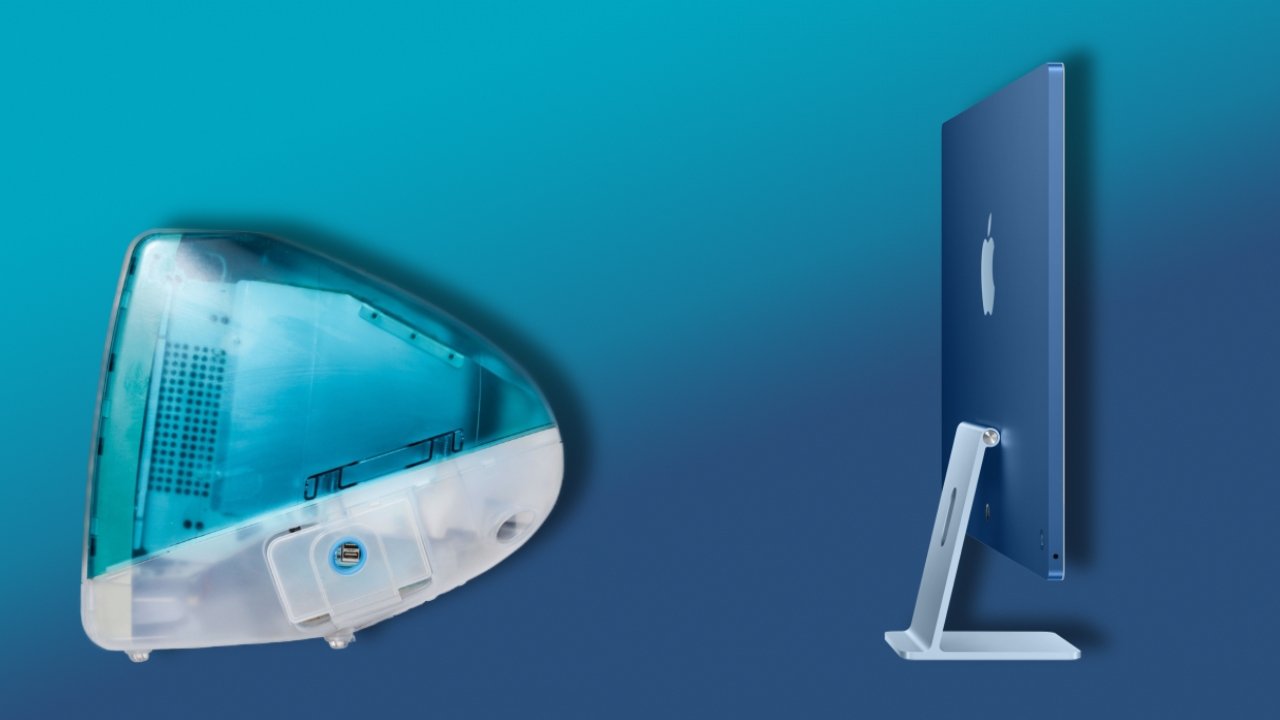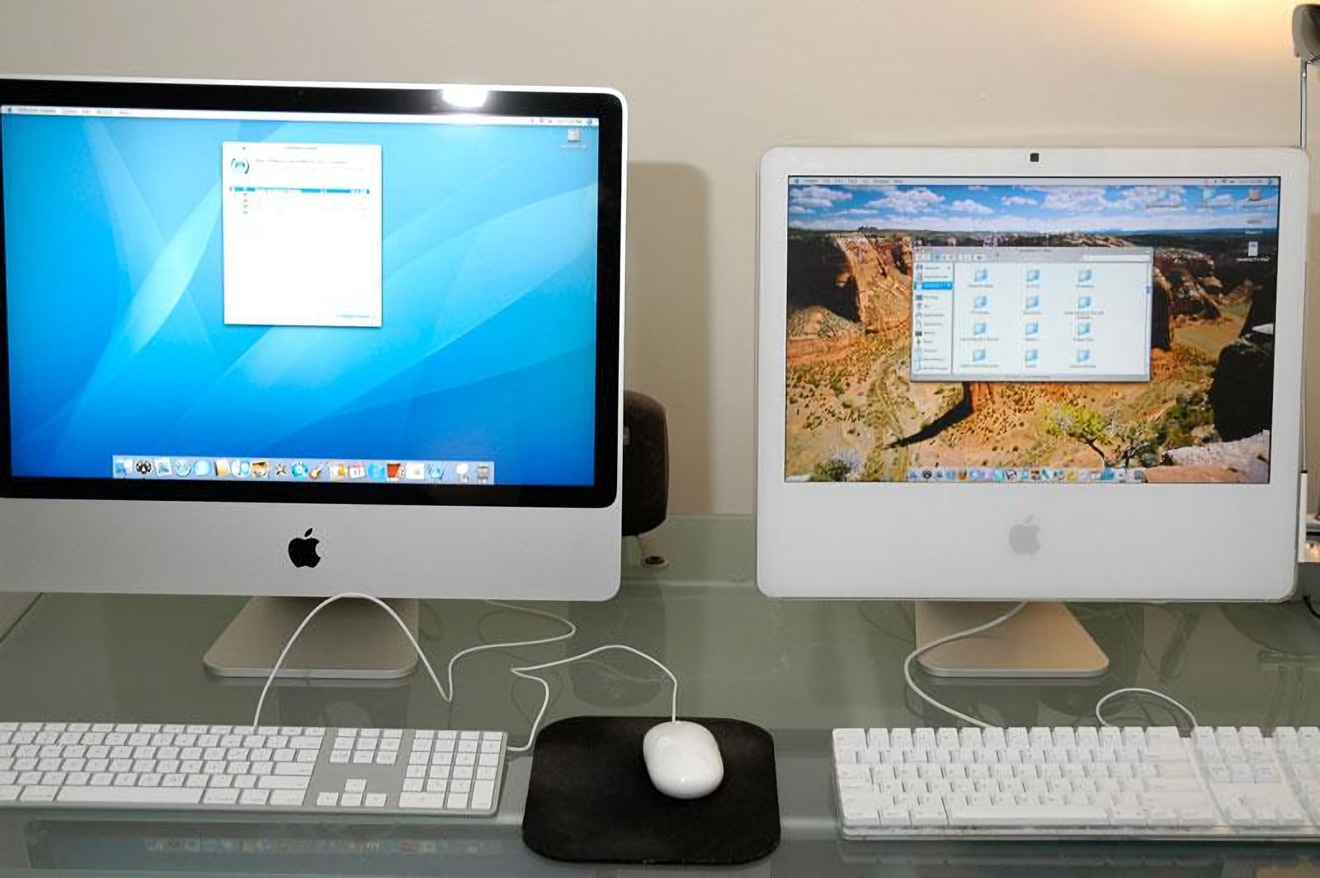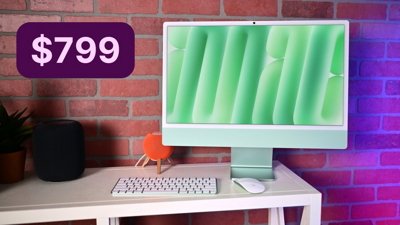First announced in 1998, the iMac was a significant departure from Apple's hardware design with transparent colorful plastic. It has gone through multiple hardware iterations over the years, with the most recent making a return to color.
After arriving at the modern unibody aluminum design in 2009, Apple kept it around for over a decade. The large hump on the back allowed plenty of thermal overhead for the power-hungry Intel processors.
Once Apple introduced the M1 processor to the iMac, the design went through a dramatic change. The 24-inch model weighs only 10 pounds and is 11.5 millimeters thin. There are seven colors available, a stark difference from the previous silver aluminum model.
Rumors pointed to a 30-inch or bigger new iMac being announced at some point, but Apple effectively squashed those rumors in November 2023. The company said it has no intention of releasing a larger 27-inch iMac with Apple Silicon, but that doesn't mean it never will release something larger, like a 30-inch model.
Apple released an M3 update for the 24-inch iMac in 2023. It changed nothing about the machine beyond the processor.
Since the M3 processor was built on an undesirable 3nm process, Apple quickly released an updated iMac with M4 in October 2024. The colors were refreshed and a Nano Texture option was included, but little else changed.
M5 is expected in 2025, but no rumors have suggested the iMac is due for an update yet.
iMac Design and Features
The iMac design saw a slow evolution through the first decade of the desktop’s existence – starting as a gumdrop-shaped, colorful plastic blob, and evolving into the silver-gray aluminum of the previous decade, then finally landing on a new thin and colorful design today. It has always had an all-in-one design, housing the motherboard and components in an area behind the display.
All-in-one
Previously, the all-in-one desktop had a 5mm tapered casing with a large hump on the back to house internal components and a prominent chin under the screen. Apple minimized the chin, removed the Apple logo, and made the body thickness uniform in the 24-inch iMac.
Despite these design changes, this desktop looks unmistakably like an Apple iMac. Rather than release an all-new form factor, Apple evolved the existing form into something much more svelt, thanks to the efficiency of the M-series processor.
The 21.5-inch iMac, iMac Pro, and 27-inch iMac have been discontinued after being replaced by the 24-inch iMac, the Mac Studio, and the Studio Display. This means the old design with the hump is no longer for sale.
The move to Apple Silicon allowed Apple to simplify its desktop lineup. Instead of following its usual strategy of offering two models, one larger with more pro chipsets, there is only one iMac available today.
The 24-inch display fits perfectly in the middle of the 21.5-inch and 27-inch models it replaces. Apple bumped the resolution to 4.5K to ensure it was still Retina, but otherwise the specs are unchanged.
Keyboard and Mouse
The external Magic Keyboard for Mac has evolved alongside the 24-inch iMac. When a customer orders a colored iMac, a color-matched Magic Mouse or Magic Trackpad and Magic Keyboard is shipped with the machine.
Customers can order only the silver/white or silver/black model separately.
Apple slimmed down the Magic Keyboard, made the edges more rounded, and added a Touch ID button to the top right corner. It can be purchased with or without a numpad, but the black color is only available with a numpad.
Despite offering USB-C on iPhone and across other devices in Apple's ecosystem, the Magic Keyboard, Magic Trackpad, and Magic Mouse were still sold with a Lightning connector until October 2024. All Magic accessories now ship with a USB-C port.
Ports
The M1, M3, and M4 processor only has enough bandwidth for two Thunderbolt/USB-4 ports. High-end configurations come with two more USB-C ports but are limited to USB-3 speeds.
The headphone jack survived the transition to Apple Silicon, but it couldn't be placed in the back of the new iMac due to its depth. The headphone jack needs 14mm of depth, whereas the new iMac is only 11.5mm thick. So, Apple compromised and placed the jack on the left side of the display.
Apple did include an Ethernet port, but not in the main body of the machine. Instead, the Ethernet jack can be found in the power brick in the middle of the power cable.
The power cable is braided and color-matched as well. It attaches magnetically to the rear of the iMac and delivers both power and data through the connection.
The iMac wasn't affected by Apple's transition to USB-C since it already used the port on the machine itself. However, Apple still ships Lightning-based accessories with the machine.
21.5-inch iMac and 27-inch iMac
The 2014 product keynote was held in October with viewers hoping to upgrade the ill-fated 2012 Mac Pro. Instead, we got the iMac 5K, a powerful machine with a new display. Apple touted it as having the highest resolution of any display at the time. The company was also quick to highlight the new timing controller and display panel it built from scratch to make the display work.
One year later, Apple introduced the 4K model with various upgrades also passed to the 5K model. These included new chipsets, SSD options, and the P3 color gamut. It was an incremental update, but the wider colors made envious many who already owned the 2014 model.
Also of note was the launch of Apple's new peripherals and an all-new rechargeable Magic Mouse, keyboard, and trackpad, which were included in the box.
The all-in-one desktops saw a performance update in March 2019. While it was in the iMac Pro's shadow, it still held firm as the budget-minded pro desktop. With the option to go all-out with an i9 processor and new Vega graphics, these computers can still fill most consumers' needs.
In August 2020, Apple changed the naming configuration of the two all-in-ones, referring to them as the 21.5-inch iMac and 27-inch iMac. They retained the same resolutions but shifted to an all-SSD lineup.
The 27-inch iMac could be configured with nano-texture glass, just like what is used in the Pro Display XDR, for an additional $500. On the 27-inch model, this update also included the T2 chip for added security.
These Intel-based machines have been phased out in favor of custom Apple Silicon and new designs.
iMac History
From the first iMacs in 1998 to the powerful M3 iMac of today, this desktop computer line has seen a rollercoaster of changes to itself and the company that produces it. Upon its release, it was the saving grace that allowed Apple to pull itself away from near bankruptcy and begin its journey to the company it is today.
Plastic to Aluminum
The transition to the sleek aluminum unibody we know today happened from 2006 to 2009. The first Intel iMac shipped with a plastic body, essentially identical to the iMac G5 it replaced. It had a white plastic body and a 17-inch screen.
Like with the MacBook Pro's transition to aluminum, the next iMac release in 2007 updated the body to an aluminum design but maintained the same screen size and aspect ratio. The 2009 update slimmed the design down a bit, changed the aspect ratio, increased the screen to 21.5" and made it an aluminum unibody.
PowerPC era
The original iMac G3 – and all subsequent models until 2006 – ran on PowerPC. Steve Jobs introduced the massively popular iMac G3 with its gumdrop design and bright colors. It saw four years of updates before Jony Ive moved the line to the white plastic floating monitor design.
The iMac G4 design was also unique with a desk-lamp-inspired design, placing the computing components in the "foot" and connecting the screen via a pivoting arm. The shift to plain white plastic was jarring, but it was also the first step in Apple moving into the more business-like silver and space gray colors it uses today.
The iMac G5 realized the aluminum unibody design used for a little over a decade. Apple then moved to its new design in 2021 with the M1 processor.
The 24-inch iMac with M4 is the only model for sale today.








 William Gallagher
William Gallagher
 Charles Martin
Charles Martin
 Amber Neely
Amber Neely
 Christine McKee
Christine McKee
 AppleInsider Staff
AppleInsider Staff

 Andrew O'Hara
Andrew O'Hara


 Oliver Haslam
Oliver Haslam